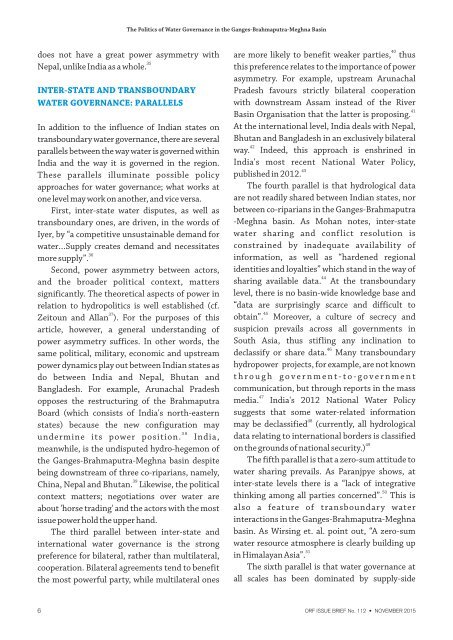The Politics of Water Governance in the Ganges-Brahmaputra-Meghna Basin
Xx6Bje
Xx6Bje
Create successful ePaper yourself
Turn your PDF publications into a flip-book with our unique Google optimized e-Paper software.
<strong>The</strong> <strong>Politics</strong> <strong>of</strong> <strong>Water</strong> <strong>Governance</strong> <strong>in</strong> <strong>the</strong> <strong>Ganges</strong>-<strong>Brahmaputra</strong>-<strong>Meghna</strong> Bas<strong>in</strong><br />
does not have a great power asymmetry with<br />
35<br />
Nepal, unlike India as a whole.<br />
INTER-STATE AND TRANSBOUNDARY<br />
WATER GOVERNANCE: PARALLELS<br />
In addition to <strong>the</strong> <strong>in</strong>fluence <strong>of</strong> Indian states on<br />
transboundary water governance, <strong>the</strong>re are several<br />
parallels between <strong>the</strong> way water is governed with<strong>in</strong><br />
India and <strong>the</strong> way it is governed <strong>in</strong> <strong>the</strong> region.<br />
<strong>The</strong>se parallels illum<strong>in</strong>ate possible policy<br />
approaches for water governance; what works at<br />
one level may work on ano<strong>the</strong>r, and vice versa.<br />
First, <strong>in</strong>ter-state water disputes, as well as<br />
transboundary ones, are driven, <strong>in</strong> <strong>the</strong> words <strong>of</strong><br />
Iyer, by a competitive unsusta<strong>in</strong>able demand for<br />
water Supply creates demand and necessitates<br />
36<br />
more supply .<br />
Second, power asymmetry between actors,<br />
and <strong>the</strong> broader political context, matters<br />
significantly. <strong>The</strong> <strong>the</strong>oretical aspects <strong>of</strong> power <strong>in</strong><br />
relation to hydropolitics is well established (cf.<br />
37<br />
Zeitoun and Allan ). For <strong>the</strong> purposes <strong>of</strong> this<br />
article, however, a general understand<strong>in</strong>g <strong>of</strong><br />
power asymmetry suffices. In o<strong>the</strong>r words, <strong>the</strong><br />
same political, military, economic and upstream<br />
power dynamics play out between Indian states as<br />
do between India and Nepal, Bhutan and<br />
Bangladesh. For example, Arunachal Pradesh<br />
opposes <strong>the</strong> restructur<strong>in</strong>g <strong>of</strong> <strong>the</strong> <strong>Brahmaputra</strong><br />
Board (which consists <strong>of</strong> India's north-eastern<br />
states) because <strong>the</strong> new configuration may<br />
3 8<br />
underm<strong>in</strong>e its power position. India,<br />
meanwhile, is <strong>the</strong> undisputed hydro-hegemon <strong>of</strong><br />
<strong>the</strong> <strong>Ganges</strong>-<strong>Brahmaputra</strong>-<strong>Meghna</strong> bas<strong>in</strong> despite<br />
be<strong>in</strong>g downstream <strong>of</strong> three co-riparians, namely,<br />
39<br />
Ch<strong>in</strong>a, Nepal and Bhutan. Likewise, <strong>the</strong> political<br />
context matters; negotiations over water are<br />
about 'horse trad<strong>in</strong>g' and <strong>the</strong> actors with <strong>the</strong> most<br />
issue power hold <strong>the</strong> upper hand.<br />
<strong>The</strong> third parallel between <strong>in</strong>ter-state and<br />
<strong>in</strong>ternational water governance is <strong>the</strong> strong<br />
preference for bilateral, ra<strong>the</strong>r than multilateral,<br />
cooperation. Bilateral agreements tend to benefit<br />
<strong>the</strong> most powerful party, while multilateral ones<br />
40<br />
are more likely to benefit weaker parties, thus<br />
this preference relates to <strong>the</strong> importance <strong>of</strong> power<br />
asymmetry. For example, upstream Arunachal<br />
Pradesh favours strictly bilateral cooperation<br />
with downstream Assam <strong>in</strong>stead <strong>of</strong> <strong>the</strong> River<br />
41<br />
Bas<strong>in</strong> Organisation that <strong>the</strong> latter is propos<strong>in</strong>g.<br />
At <strong>the</strong> <strong>in</strong>ternational level, India deals with Nepal,<br />
Bhutan and Bangladesh <strong>in</strong> an exclusively bilateral<br />
42<br />
way. Indeed, this approach is enshr<strong>in</strong>ed <strong>in</strong><br />
India's most recent National <strong>Water</strong> Policy,<br />
43<br />
published <strong>in</strong> 2012.<br />
<strong>The</strong> fourth parallel is that hydrological data<br />
are not readily shared between Indian states, nor<br />
between co-riparians <strong>in</strong> <strong>the</strong> <strong>Ganges</strong>-<strong>Brahmaputra</strong><br />
-<strong>Meghna</strong> bas<strong>in</strong>. As Mohan notes, <strong>in</strong>ter-state<br />
water shar<strong>in</strong>g and conflict resolution is<br />
constra<strong>in</strong>ed by <strong>in</strong>adequate availability <strong>of</strong><br />
<strong>in</strong>formation, as well as hardened regional<br />
identities and loyalties which stand <strong>in</strong> <strong>the</strong> way <strong>of</strong><br />
44<br />
shar<strong>in</strong>g available data. At <strong>the</strong> transboundary<br />
level, <strong>the</strong>re is no bas<strong>in</strong>-wide knowledge base and<br />
data are surpris<strong>in</strong>gly scarce and difficult to<br />
45<br />
obta<strong>in</strong> . Moreover, a culture <strong>of</strong> secrecy and<br />
suspicion prevails across all governments <strong>in</strong><br />
South Asia, thus stifl<strong>in</strong>g any <strong>in</strong>cl<strong>in</strong>ation to<br />
46<br />
declassify or share data. Many transboundary<br />
hydropower projects, for example, are not known<br />
t h r o u g h g o v e r n m e n t - t o - g o v e r n m e n t<br />
communication, but through reports <strong>in</strong> <strong>the</strong> mass<br />
47<br />
media. India's 2012 National <strong>Water</strong> Policy<br />
suggests that some water-related <strong>in</strong>formation<br />
48<br />
may be declassified (currently, all hydrological<br />
data relat<strong>in</strong>g to <strong>in</strong>ternational borders is classified<br />
49<br />
on <strong>the</strong> grounds <strong>of</strong> national security.)<br />
<strong>The</strong> fifth parallel is that a zero-sum attitude to<br />
water shar<strong>in</strong>g prevails. As Paranjpye shows, at<br />
<strong>in</strong>ter-state levels <strong>the</strong>re is a lack <strong>of</strong> <strong>in</strong>tegrative<br />
50<br />
th<strong>in</strong>k<strong>in</strong>g among all parties concerned . This is<br />
also a feature <strong>of</strong> transboundar y water<br />
<strong>in</strong>teractions <strong>in</strong> <strong>the</strong> <strong>Ganges</strong>-<strong>Brahmaputra</strong>-<strong>Meghna</strong><br />
bas<strong>in</strong>. As Wirs<strong>in</strong>g et. al. po<strong>in</strong>t out, A zero-sum<br />
water resource atmosphere is clearly build<strong>in</strong>g up<br />
51<br />
<strong>in</strong> Himalayan Asia .<br />
<strong>The</strong> sixth parallel is that water governance at<br />
all scales has been dom<strong>in</strong>ated by supply-side<br />
6 ORF ISSUE BRIEF No. 112 • NOVEMBER 2015








